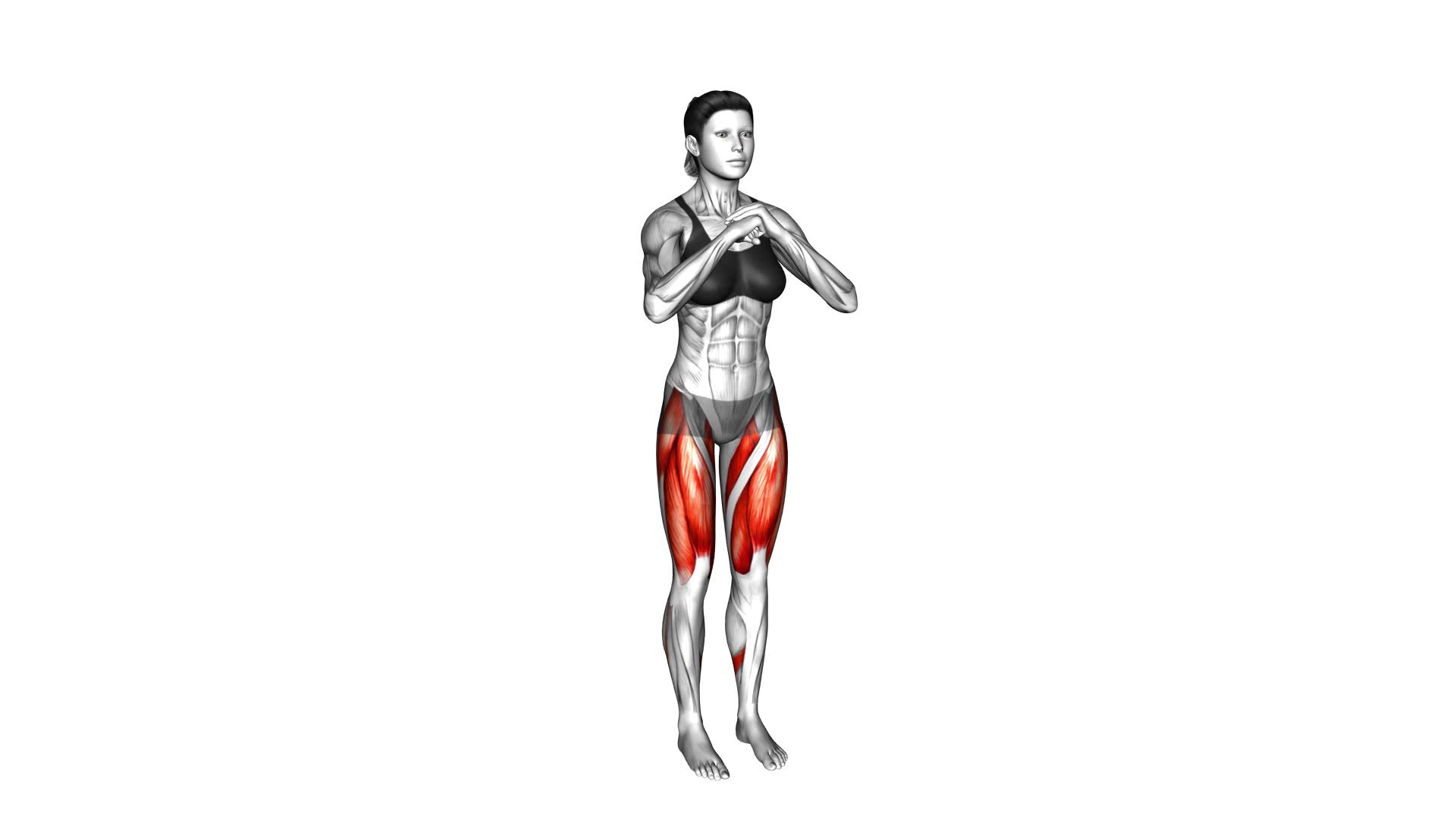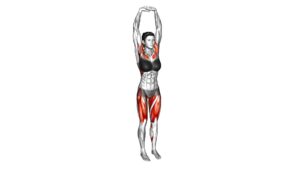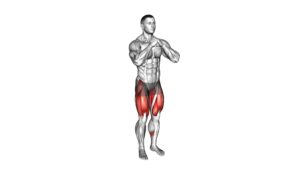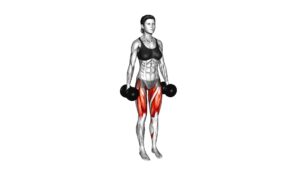Curtsy Squat (female) – Video Exercise Guide & Tips

Are you looking to tone your legs and strengthen your lower body? Look no further than the curtsey squat!
Watch This Exercise Video
This video exercise guide will teach you the proper form and technique, as well as provide helpful tips to maximize your results.
Avoid common mistakes and discover variations and progressions to challenge yourself.
Incorporate the curtsey squat into your workout routine for a more sculpted and powerful physique.
Let's get started!
Key Takeaways
- The curtsey squat targets multiple muscle groups including the glutes, quads, and hamstrings.
- It improves balance, stability, and overall lower body strength and power.
- There are various variations of the curtsey squat that can be incorporated for added challenge and muscle engagement.
- Equipment such as dumbbells or a barbell can be used to increase resistance and maximize the effectiveness of the exercise.
Benefits of the Curtsey Squat
You can experience numerous benefits by incorporating the curtsey squat into your workout routine. This exercise primarily targets your glutes, quads, and hamstrings, helping to strengthen and tone these muscle groups. By engaging multiple muscles at once, the curtsey squat can also improve your overall balance and stability. Additionally, this exercise can increase your lower body strength and power, which can be beneficial for various sports and activities.
One of the great things about the curtsey squat is that it offers variations to suit different fitness levels and goals. If you're a beginner, you can start with bodyweight curtsey squats, gradually increasing the intensity as you get stronger. For a more challenging workout, you can incorporate dumbbells or a barbell to add resistance. Another variation is the curtsey lunge, where you step back into a curtsey position, instead of crossing one leg behind the other. This variation further targets your glutes and inner thighs.
Incorporating the curtsey squat into your routine can help you achieve a more sculpted lower body, improve your balance, and increase your overall strength. So why not give it a try and start reaping the benefits today?
Equipment Needed for the Curtsey Squat
To perform the curtsey squat effectively, there are a few essential pieces of equipment that you'll need. These include a set of dumbbells or a barbell, depending on your preference and fitness level.
However, if you don't have access to traditional equipment, there are alternative options such as using water bottles or resistance bands.
Essential Equipment for Curtsey Squat
To perform the Curtsey Squat, you'll need a few essential pieces of equipment. One option is to use resistance bands, which add extra tension to your muscles during the exercise. Resistance bands come in different levels of resistance, allowing you to gradually increase the difficulty as you get stronger.
Another option is to use dumbbells, which provide additional weight to challenge your muscles. Holding a dumbbell in each hand while performing the Curtsey Squat can help increase the intensity of the exercise. These pieces of equipment are great for adding resistance and making the Curtsey Squat more effective.
However, if you don't have access to resistance bands or dumbbells, there are alternative options available that can still provide a challenging workout.
Alternatives to Traditional Equipment
One alternative to traditional equipment for the Curtsey Squat is using a stability ball. Here are four alternative exercises for the Curtsey Squat that can be done as bodyweight workouts:
- Reverse Lunge: Instead of crossing one leg behind the other, take a step back with one foot and lower your body into a lunge position. This exercise targets the same muscles as the Curtsey Squat.
- Side Lunge: Step to the side with one foot, keeping the other foot planted. Bend the knee of the stepping leg and lower your body into a lunge position. This exercise works the same muscles as the Curtsey Squat but engages them in a different way.
- Bulgarian Split Squat: Place one foot on a bench or step behind you and lower your body into a squat position. This exercise is similar to the Curtsey Squat and targets the same muscle groups.
- Pistol Squat: Stand on one leg and lower your body into a squat position, keeping the other leg extended in front of you. This exercise challenges your balance and targets the same muscles as the Curtsey Squat.
These alternative exercises can be done without traditional equipment, making them great options for bodyweight workouts.
Maximizing Effectiveness With Equipment
To maximize the effectiveness of the Curtsey Squat and perform it with the necessary equipment, you'll need a dumbbell or kettlebell. Adding weight to your Curtsey Squats won't only challenge your muscles more, but also maximize your results.
Holding a dumbbell or kettlebell at your chest level or by your sides will provide the added resistance needed to increase the intensity of the exercise. By using this equipment, you'll engage your lower body muscles even more, including your glutes, quads, and hamstrings.
If you don't have access to a dumbbell or kettlebell, you can still perform the Curtsey Squat without any equipment. However, incorporating weights will help you reach your fitness goals faster and see better overall results.
Proper Form and Technique for the Curtsey Squat
Ensure proper form and technique for the curtsey squat by positioning your feet shoulder-width apart and keeping your chest lifted throughout the exercise. This compound movement targets multiple muscle groups, primarily the glutes, quadriceps, and hamstrings.
Here are some tips to help you perform the curtsey squat correctly:
- Start by standing with your feet shoulder-width apart, toes pointing forward.
- Take a big step diagonally backward with your left leg, crossing it behind your right leg. Keep your torso upright.
- Bend both knees and lower your body down until your right thigh is parallel to the floor. Ensure your left knee hovers above the ground.
- Push through your right heel to return to the starting position. Repeat on the other side.
By following these guidelines, you can maximize the benefits of the curtsey squat. This exercise helps improve lower body strength and stability, enhances balance, and tones the glutes and thighs. Additionally, it can be modified by using dumbbells or resistance bands to increase the intensity. Remember to listen to your body and start with lighter weights if you're a beginner.
Incorporating curtsey squats into your workout routine can contribute to a well-rounded lower body workout for women.
Common Mistakes to Avoid During the Curtsey Squat
To avoid common mistakes during the curtsey squat, focus on maintaining proper form and technique.
One common mistake isn't keeping the chest up and the core engaged throughout the movement. It's important to keep your back straight and avoid rounding the shoulders. This will help to prevent strain on the lower back and maintain stability.
Another mistake is allowing the knees to collapse inward during the squat. To avoid this, make sure to keep your knees in line with your toes throughout the exercise.
Additionally, some people tend to shift their weight onto one leg more than the other, which can lead to imbalances and uneven muscle development. To prevent this, distribute your weight evenly between both legs and focus on maintaining a balanced stance.
Lastly, avoid rushing through the movement. Take your time and focus on performing the curtsey squat with control and precision.
Variations and Progressions of the Curtsey Squat
Now let's explore some variations and progressions to take your curtsey squat to the next level.
First, focus on refining your technique by ensuring proper form and alignment throughout the movement.
Next, you can add resistance options such as using dumbbells or a barbell to increase the challenge.
Lastly, consider increasing the range of motion by stepping farther back or adding a pulse at the bottom of the squat.
These progressions will help you continue to challenge your muscles and improve your strength and stability.
Technique Refinements
Try incorporating different variations and progressions into your curtsey squat routine to challenge your muscles in new ways. By refining your technique and improving your execution, you can maximize the effectiveness of this exercise.
Here are four variations and progressions to consider:
- Weighted Curtsey Squats: Hold a dumbbell or kettlebell in each hand to increase the resistance and intensity of the exercise.
- Jumping Curtsey Squats: Add a plyometric element by jumping explosively as you switch legs, increasing power and cardiovascular demands.
- Single-Leg Curtsey Squats: Perform the exercise on one leg at a time to improve balance, stability, and target each leg individually.
- Curtsey Squat with Resistance Band: Place a resistance band around your thighs to activate your glutes and enhance the engagement of your leg muscles.
Incorporating these variations and progressions will challenge your muscles in different ways, helping you to continuously improve and achieve your fitness goals.
Adding Resistance Options
As you progress in your curtsey squat routine, you can elevate the challenge by incorporating different resistance options.
Adding resistance helps to further strengthen your muscles and increase the intensity of the exercise.
One option is to hold dumbbells in your hands while performing the curtsey squat. This adds weight and resistance, making the exercise more challenging.
Another option is to use a resistance band around your thighs. This provides constant tension throughout the movement, targeting your glutes and thighs even more.
You can also modify your form by performing jump curtsey squats, where you jump explosively from one side to the other, adding a plyometric element to the exercise.
Remember to start with lighter weights or bands and gradually increase as you get stronger.
Increasing Range of Motion
To further challenge yourself in your curtsey squat routine, you can progress by exploring variations and progressions that increase the range of motion. Here are four ways to do so:
- Deep Curtsey Squat: Instead of just tapping your foot behind you, lower your back knee closer to the ground, increasing the depth of the squat and stretching your hip flexors.
- Overhead Curtsey Squat: Hold a dumbbell or kettlebell overhead while performing the curtsey squat. This not only increases the range of motion but also adds an upper body challenge.
- Curtsey Lunge with Rotation: As you lower into the curtsey lunge, rotate your torso towards the front leg. This variation increases flexibility in the hips and spine, while also engaging the core.
- Single-Leg Curtsey Squat: Perform the curtsey squat on one leg, with the other leg lifted off the ground. This variation improves stability and balance while increasing the range of motion in the working leg.
Tips for Incorporating the Curtsey Squat Into Your Workout Routine
To effectively incorporate the curtsey squat into your workout routine, consistently perform this exercise at least three times a week. If you want to take your curtsey squats to the next level, try incorporating weights into your routine. Holding dumbbells or a barbell across your shoulders will add resistance and increase the intensity of the exercise. Start with lighter weights and gradually increase as you become more comfortable and confident.
In addition to incorporating weights, you can also incorporate variations of the curtsey squat to target different muscle groups. One variation is the curtsey lunge, where instead of squatting, you lunge backward diagonally, crossing one leg behind the other. This variation engages your glutes and inner thighs even more. Another variation is the jumping curtsey squat, where you explode off the ground as you switch legs, adding a plyometric element to the exercise and challenging your cardiovascular system.
When performing curtsey squats and their variations, it's important to maintain proper form. Keep your chest up, back straight, and core engaged throughout the movement. Step back at a diagonal angle, ensuring your knees stay aligned with your toes. As you lower into the squat, aim to bring your back knee close to the ground without touching it. Push through your front heel to return to the starting position.
Frequently Asked Questions
How Many Sets and Repetitions Should I Do for the Curtsey Squat?
To get the most out of the curtsey squat, it's important to know how many sets and repetitions to do. The number of sets and reps will depend on your fitness level and goals.
Generally, starting with 2-3 sets of 8-12 reps is a good place to begin. This exercise offers various benefits, such as targeting the glutes, quads, and hamstrings.
Additionally, there are different variations you can try to keep things interesting and challenge your muscles.
Can I Do the Curtsey Squat if I Have Knee or Hip Pain?
If you're dealing with knee or hip pain, it's important to be cautious when doing the curtsey squat. This exercise can put strain on those areas, so modifications may be needed.
Listen to your body and don't push through any pain. Consider speaking with a healthcare professional or a certified trainer for advice on coping with knee pain and modifying the curtsey squat to suit your needs.
Safety should be the top priority when it comes to exercise.
Should I Use Weights While Performing the Curtsey Squat?
When performing the curtsey squat, you may wonder if you should use weights. Using weights can increase the intensity of the exercise and help strengthen your glutes even more. By adding resistance, you challenge your muscles and promote muscle growth. This can lead to improved strength and stability in your hips and knees.
However, it's important to start with lighter weights and gradually increase as you feel comfortable. Always listen to your body and consult with a fitness professional for personalized guidance.
What Muscles Does the Curtsey Squat Target?
The curtsey squat is a fantastic exercise for women's fitness. It targets several key muscle groups, including the glutes, quads, hamstrings, and inner thighs. By incorporating this exercise into your routine, you can strengthen and tone these areas, leading to improved overall lower body strength and stability.
To add an extra challenge, you can try variations such as holding weights or performing the squat on an unstable surface. These variations will further engage your core and challenge your balance.
Can the Curtsey Squat Help Improve My Balance?
Adding curtsey squats to your workout routine can help improve your balance. By engaging the muscles in your legs and glutes, this exercise challenges your stability and coordination.
To modify the curtsey squat for beginners, start with a smaller range of motion and gradually increase as you gain strength.
The benefits of this exercise extend beyond balance, as it also targets your quadriceps, hamstrings, and hip abductors.
Incorporate curtsey squats into your workouts for a well-rounded lower body workout.
Conclusion
Incorporating the curtsey squat into your workout routine can provide numerous benefits, including improved lower body strength and stability.
To perform this exercise correctly, make sure to maintain proper form and avoid common mistakes.
As you progress, you can also try different variations of the curtsey squat to challenge yourself further.
By following these tips and incorporating this exercise into your routine, you can enhance your overall fitness and achieve your fitness goals.

Author
Years ago, the spark of my life’s passion ignited in my mind the moment I stepped into the local gym for the first time. The inaugural bead of perspiration, the initial endeavor, the very first surge of endorphins, and a sense of pride that washed over me post-workout marked the beginning of my deep-seated interest in strength sports, fitness, and sports nutrition. This very curiosity blossomed rapidly into a profound fascination, propelling me to earn a Master’s degree in Physical Education from the Academy of Physical Education in Krakow, followed by a Sports Manager diploma from the Jagiellonian University. My journey of growth led me to gain more specialized qualifications, such as being a certified personal trainer with a focus on sports dietetics, a lifeguard, and an instructor for wellness and corrective gymnastics. Theoretical knowledge paired seamlessly with practical experience, reinforcing my belief that the transformation of individuals under my guidance was also a reflection of my personal growth. This belief holds true even today. Each day, I strive to push the boundaries and explore new realms. These realms gently elevate me to greater heights. The unique combination of passion for my field and the continuous quest for growth fuels my drive to break new ground.







